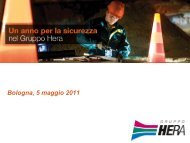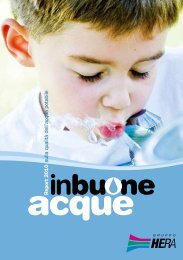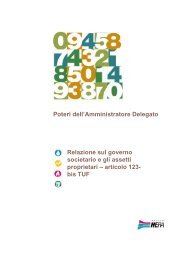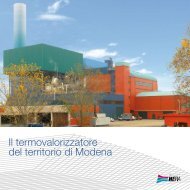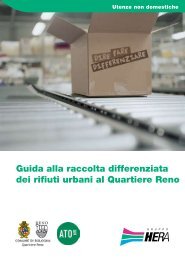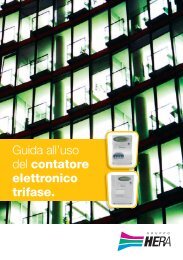I termovalorizzatori del Gruppo Hera - Il Gruppo Hera
I termovalorizzatori del Gruppo Hera - Il Gruppo Hera
I termovalorizzatori del Gruppo Hera - Il Gruppo Hera
Create successful ePaper yourself
Turn your PDF publications into a flip-book with our unique Google optimized e-Paper software.
I vantaggi <strong>del</strong>latermovalorizzazioneTermovalorizzazione: panoramanazionale e internazionaleLa termovalorizzazione è un sistema di smaltimentoestremamente utile perché:• rappresenta una soluzione duratura rispettoalle esigenze di smaltimento <strong>del</strong>la produzionequotidiana di rifiuti determinata dai consumi<strong>del</strong>la società contemporanea;• produce energia con conseguente risparmioI rifiuti che vengono trattati nei <strong>termovalorizzatori</strong><strong>del</strong> <strong>Gruppo</strong> <strong>Hera</strong> producono la stessa quantità dienergia elettrica e termica per la quale sarebbe statonecessario l’utilizzo di oltre 122.000 tonnellate dipetrolio. Questo determina un notevole vantaggioper l’ambiente perchè si usa un prodotto di scartopreservando combustibile di origine fossile.I rifiuti trattatinei <strong>termovalorizzatori</strong>producono energiaelettrica e termicaevitando l’utilizzodi oltre 122.000tonnellate di petrolio.I sistemi di gestione dei rifiuti sono diversificati tra i paesiindustrializzati. Negli ultimi anni, pur essendo aumentatii sistemi di recupero, riciclaggio e termotrattamento,in molti Paesi, Italia e Gran Bretagna in primis,rimane ancora l’uso <strong>del</strong>la discarica come principaledestinazione <strong>del</strong>lo smaltimento.Tra i Paesi che ne minimizzano l’uso, Svizzera,Danimarca e Francia; in Italia, oggi, su 28 milionidi tonnellate di rifiuti solidi urbani, solo l’8% è destinatoalla termocombustione.Da un censimento recente di Federambiente, nel Paeseci sono 63 impianti, di cui funzionanti 40 e solo in alcuniè impiegata la tecnologia che permette il recuperoenergetico; l’efficienza energetica di tipo elettrico28 | Vienna, l’impiantodi termovalorizzazioneSpittelau.di altri combustibili spesso ottenuti da fontiDanimarca e Svezia ricorrono in misura preponderantesi stima in 200-300 Kwh/tonn.non rinnovabili di origine fossile, scarsamentealla termovalorizzazione, combinandola con alti livelli diL’utilizzo <strong>del</strong>la termovalorizzazione in Italia è dunquedisponibili in Italia;The waste processedraccolta differenziata, diversamente da quanto avvieneancora limitato se confrontato a quello europeo,in the waste-to-energyin Francia e Giappone, dove, a un’elevata quantitàma esistono dei presupposti per un buono sviluppo,plants generatesdi rifiuti termovalorizzati si associano invece basseanche in tempi rapidi. Le esperienze pilota di alcunethe same amountpercentuali di differenziata.realtà locali, anche se non organiche ad alcun pianoof electricity and heatLa termovalorizzazione in Europa è presente condi sviluppo, hanno portato a buoni risultati e alas over 122,000circa 300 impianti, di cui buona parte in Svizzera,mantenimento <strong>del</strong> presidio tecnologico di settore in Italia.tonnes of oil.Advantages ofwaste-to-energyWaste-to-energy is an invaluablemethod of waste disposal since:• it represents a lastingsolution in view of the needto dispose of the wasteproduced each day by today’sconsumer society;• it generates energy andtherefore saves on otherfuels, often obtained fromnon-renewable sources (fossilfuels), which are in shortsupply in Italy.The waste treated in <strong>Hera</strong>’swaste-to-energy plantsgenerates the same amountof electricity and heat as over122,000 tonnes of oil. This isextremely environmentallyfriendlybecause a waste productis used instead of fossil fuels.Waste-to-energy:the national andinternationalpictureWaste management systemsdiffer from one industrialisedcountry to the next. In recentyears, although recovery,recycling and thermal treatmentsystems have increased, in manycountries – not least of all Italyand the UK – waste often stillends up in landfill sites.Of the countries that use thesethe least, Switzerland, Denmarkand Sweden are increasinglyresorting to waste-to-energytreatment, combining this withhigh levels of recycling. In Franceand Japan the picture is verydifferent: despite the significantvolume of waste processedusing WTE, the proportionof recycling remains low.In Europe, there are around 300waste-to-energy plants, manyof them in Switzerland, Denmarkand France. Today in Italy,of the 28 million tonnes of solidurban waste, only 8% is usedfor thermal combustion.According to a recentFederambiente survey, there are63 plants in Italy, 40 of whichare in operation and only someof which use energy recoverytechnology; electrical energyefficiency is estimated at 200-300 Kwh/tonnes.The use of waste-to-energyin Italy is therefore still limitedcompared to the rest of Europe,although there are positive signsthat it will grow rapidly. Somelocal pilot schemes, althoughnot part of a formal developmentplan, have yielded good resultsand have helped to promotethe sector in Italy.28 | Vienna, the Spittelauwaste-to-energy plant44 | I <strong>termovalorizzatori</strong> <strong>del</strong> <strong>Gruppo</strong> <strong>Hera</strong> | La termovalorizzazionehera group’s waste-to-energy plants | Waste-to-energy production | 45




